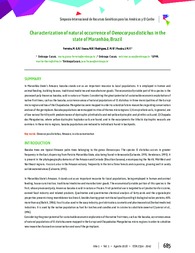Characterization of natural occurrence of Oenocarpus distichus in the state of Maranhão, Brazil.
Characterization of natural occurrence of Oenocarpus distichus in the state of Maranhão, Brazil.
Author(s): FERREIRA, M. das G. R.; SOUSA, N. R.; RODRIGUES, Z. M. R.; FRAZAO, J. M. F.
Summary: In Maranhão States Amazon, bacaba stands out as an important resource to local populations. It is employed in human and animal feeding, building houses, traditional medicine and manufacturer goods. The economically viable part of this species is the processed pulp known as bacaba, sold in natura or frozen. Considering the great potential of sustainable economic exploitation of native fruit trees, such as the bacaba, occurrence areas of natural populations of O. distichus in three municipalities of the Gurupi micro region and two of the Chapada das Mangabeiras were mapped in order to subsidize future researches regarding conservation and use of the germplasm. Bacaba populations were mapped in cities of the two microregions: 1) Gurupi where soils, in general, are of low natural fertility with predominance of dystrophic plinthudults and red-yellow dystrophic and plinthic soils and; 2) Chapada das Mangabeiras, where yellow dystrophic hapludox soils are found; and in the escarpments the litholic dystrophic neosoils are common. In these micro regions, bacaba populations are reduced to individuals found in backyards.
Publication year: 2018
Types of publication: Abstract in annals or event proceedings
Unit: Embrapa Maranhão
Keywords: Bacaba, Maranhão, Oenocarpus Distichus
Observation
Some of Embrapa's publications are published as ePub files. To read them, use or download one of the following free software options to your computer or mobile device. Android: Google Play Books; IOS: iBooks; Windows and Linux: Calibre.
Access other publications
Access the Agricultural Research Database (BDPA) to consult Embrapa's full library collection and records.
Visit Embrapa Bookstore to purchase books and other publications sold by Embrapa.

